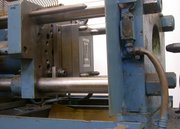|
Plastic
Product Manufacturing Technology
Injection
moulding
Injection moulding (United States Injection
Molding) is a manufacturing technique for making parts from
plastic material. Molten plastic is injected at high pressure
into a mould, which is the inverse of the desired shape. The
mould is made by a mouldmaker (or toolmaker) from metal, usually
either steel or aluminium, and precision-machined to form the
features of the desired part. Injection moulding is very widely
used for manufacturing a variety of parts, from the smallest
component to entire body panels of cars. It is the most common
method of production, with some commonly made items including
bottle caps and outdoor furniture.
Mould
Paper clip mould opened in moulding machine, the nozzle is
visible at rightConsiderable thought is put into the design of
moulded parts and their moulds, to ensure that the parts will not
be trapped in the mould, that the moulds can be completely filled
before the molten resin solidifies, to compensate for material
shrinkage, and to minimize imperfections in the parts, which can
occur due to peculiarities of the process.
Moulds separate into at least two halves�called the core and the
cavity�to permit the part to be extracted; in general the shape
of a part must be such that it will not be locked into the mould.
For example, sides of objects typically cannot be parallel with
the direction of draw�the direction in which the core and cavity
separate from each other. They are angled slightly; examination
of most household objects made from plastic will show this aspect
of design, known as draft. Parts that are "bucket-like" tend to
shrink onto the core while cooling and, after the cavity is
pulled away, are typically ejected using pins. More complex parts
are formed using more complex moulds, which may require moveable
sections, called slides, which are inserted into the mould to
form particular features that cannot be formed using only a core
and a cavity, but are then withdrawn to allow the part to be
released.
The resin, or raw material for injection moulding, is usually in
pellet form, and is melted by heat and pressure shortly before
being injected into the mould. The channels through which the
plastic flows toward the chamber will also solidify, forming an
attached frame. This frame is composed of the sprue, which is the
main channel from the reservoir of molten resin, parallel with
the direction of draw, and runners, which are perpendicular to
the direction of draw, and are used to convey molten resin to the
gate(s), or point(s) of injection. The sprue and runner system
can be cut off and recycled. Some moulds are designed such that
it is automatically stripped from the part through action of the
mould.
The quality of the moulded part depends on the quality of the
mould, the care taken during the moulding process, and upon
details of the design of the part itself. It is essential that
the molten resin be at just the right pressure and temperature,
so that it flows easily to all parts of the mould. The parts of
the mould must also come together extremely precisely, otherwise
small leakages of molten plastic can form, a phenomenon known as
flash. When filling a new or unfamiliar mould for the first time,
where shot size for that particular mould is unknown, a
technician should reduce the nozzle pressure so that the mould
fills, but does not flash. Then, using that now-known shot
volume, pressure can be raised without fear of damaging the
mould.
Traditionally, moulds have been very expensive to manufacture
therefore they were usually only used in mass production where
thousands of parts are being produced. Moulds are typically
constructed from hardened steel or aluminium. The choice of
material to build a mould is primarily one of economics. Steel
moulds generally cost more to construct, but their longer
lifespan will offset the higher initial cost over a higher number
of parts made in the mould before wearing out. Aluminium moulds
can cost substantially less, and when designed and machined with
modern computerized equipment, can be economical for moulding
hundreds or even tens of parts.
Small injection moulder showing hopper, nozzle and die areaHeated
plastic is forced under pressure into a mould cavity; it is then
clamped together and solidifies into the shape of the mould
creating the part.
Resin pellets are poured into the Feed hopper, a large open
bottomed container, which feeds the granules down to the screw.
The screw is turned by hydraulic or electric motor that turns the
screw feeding the pellets up the screw's grooves. The depths of
the screw flights decreases towards the end of the screw nearest
the mould. As the screw rotates, the pellets are moved forward in
the screw and they undergo extreme pressure and friction which
generates most of the heat needed to melt the pellets. Heaters on
either side of the screw assist in the heating and temperature
control around the pellets during the melting process. The screw
travel limit switches set the distance the screw moves.
The hydraulic system pumps oil from the oil tank to firmly close
the male and female mould parts, that run along the tie bar; the
liquid resin is then injected into the mould. Since the moulds
are clamped shut by the hydraulics, the heated plastic is forced
under the pressure of the injection screw to take the shape of
the mould. The water-cooling channels then assist in cooling the
mould and the heated plastic solidifies into the part.
Making Rayon Fiber
| 

 Plastics Engineering
Plastics Engineering



 Knowledge Base
Knowledge Base

















 Knowledge Base
Knowledge Base


